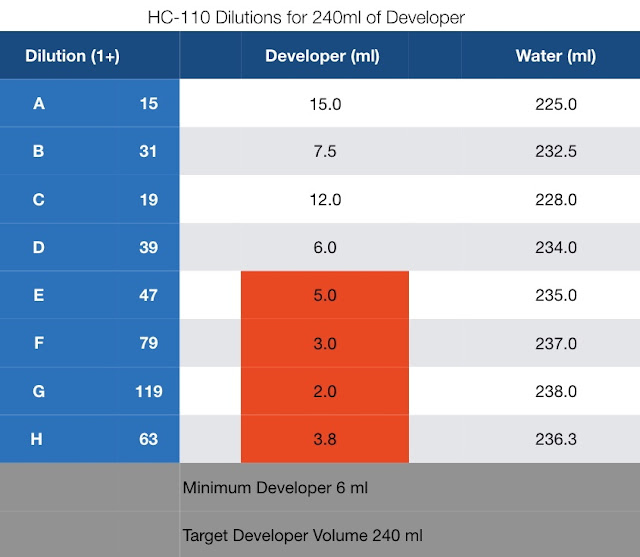HC-110 Developer Measurement Techniques
Introduction
This first section is meant as background to justify why I chose to do things the way I do. You can skip ahead to the developer mixing section to get to the gist of the article.In an earlier post I describe the re-purposing of Cibachrome drums for 4x5 and 8x10 sheet film development.
One-Shot Developer
Part of that was my determination to use HC-110 developer as one-shot. I have come to understand that I am not a consistent enough user of film developer to keep bottles of it lying around. The result is that I worry about whether the developer is fresh. I do not want to risk my images on possibly expired/old developer. You then get into the problem of tracking of how much film has been through the developer and possibly extending developing times depending on how much film has been through the developer. Eventually I realized there is a certain amount of developer that is used each time and so there isn’t really an idea of ‘saving developer’.This all lead me to conclude the mixing fresh developer wasn’t really that much trouble. So I am now a convert to one-shot. I get fresh chemistry every time. The development is consistent because of this and I don’t risk my images.
Developer Dilution
Once you accepted that a given strength of developer develops only so many sheets of film then the reuse of concentrated developer while seeming economical is actually the same amount of chemical. For instance HC-110 has a recommended a minimum of 6ml of developer per roll of 35mm (36exp), 120, or four 4x5 films or one 8x10 film.HC-110 also has many dilutions that are well documented from A-H. That means I can set a dilution based on 6ml of developer for one sheet of 8x10 or 4 sheets of 4x5.
Since the drum holds about 250ml of developer in the reservoir I would aim to find the dilution at or above 6ml of developer that fits that. The table below supplies the dilutions for 240ml of developer. (E through H cannot supply the 6ml of developer required for one sheet of 8x10 film and shown in red.) Dilutions B or D suit my requirements for one shot dilution best as they are closest to the 6ml minimum. Dilution B has common times in Massive Dev Chart and elsewhere. D can be estimated at +25% longer. (Dilution B can be used at 6.3ml to make 200ml of developer as well.)
Measuring and Mixing Developer
I find when mixing HC110, the syrup is a real pain. I took the advice of someone online to store in a number of smaller squeeze bottles (I use dish soap and honey bottles) to store it. (Keep it away from kids and label it appropriately as it does look like honey!) You can squeeze out small amounts easily and squeeze the air out before closing the lid preserving the developer.For measurement I used to use a pipette but found it a pain to wash the sticky developer into the solution. I use dilution B which I compute as 7.5ml with 232.5ml of water. (From the table above.) I have a small digital scale with .1 gram resolution I use for mixing darkroom solutions.
I figured out I could measure the amount of HC-110 I need on my scale and use the published specific gravity from the MSDS (Material Safety Data Sheet) which Kodak says is 1.24. So 7.5ml x 1.24g/ml = 9.3 grams. I place my empty bottle on the scale hit the tare button to zero the display then add water till I get to 232.5g(ml). I then hit the tare button again and add syrup till I get 9.3 grams. Since I am adding syrup to the water it dissolves more easily. A quick shake mixes it and I am good to go. I use this single shot to develop up to four 4x5 film sheets ( or one roll of 35mm or 120 or one 8x10 sheet).
If I am developing 120 film in my Paterson drum I mix double the recipe as the tank requires a minimum volume to cover the film. This is good for two rolls if I want to be economical.
I find using gram measurements much easier than syringes or pipettes.
I made a video showing how I do this as well...

Comments
Anyway your risk of error is mostly 10% so to my opinion you could round the decimals.
Greetings from Switzerland
Hubertus
Thank you for commenting!
I am not at all sure of the level of accuracy required. I guess I was too well trained in high school chemistry where precision and cleanliness were drilled into me! I read on Kodak’s data sheet
“When measuring small amounts of concentrate, use a graduated cylinder accurate to 0.5 millilitre. “
Also warnings about syrup sticking to containers and removing air bubbles.
.5ml in 7.5 ml is 6.7% so I suppose it is a little overkill for accuracy.
Accuracy I feel is but one benefit as it is also simpler, easier to be more consistent and simpler cleanup.
Doug